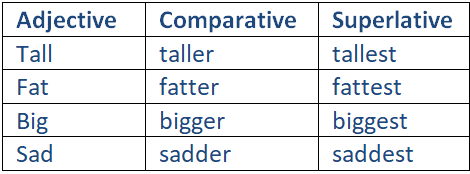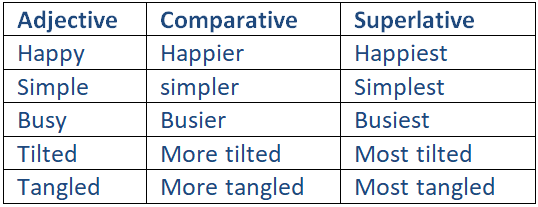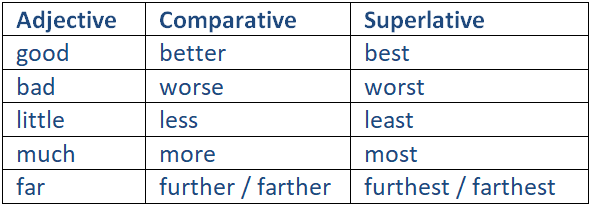
Comparative and Superlative
 المؤلف:
EF.COM
المؤلف:
EF.COM
 المصدر:
...
المصدر:
...
 الجزء والصفحة:
...
الجزء والصفحة:
...
 9-6-2021
9-6-2021
 1223
1223
Comparative adjectives
Comparative adjectives are used to compare differences between the two objects they modify (larger, smaller, faster, higher). They are used in sentences where two nouns are compared, in this pattern:
Noun (subject) + verb + comparative adjective + than + noun (object).
The second item of comparison can be omitted if it is clear from the context (final example below).
Examples
My house is larger than hers.
This box is smaller than the one I lost.
Your dog is faster than Jim's dog.
The rock is higher than the roof.
Jim and Jack are both fast, but Jack is faster. ("than Jim" is understood)
Superlative adjectives
Superlative adjectives are used to describe an object which is at the upper or lower limit of a quality (the tallest, the smallest, the fastest, the highest). They are used in sentences where a subject is compared to a group of objects.
Noun (subject) + verb + the + superlative adjective + noun (object).
The group that is being compared with can be omitted if it is clear from the context (final example below).
Examples
My house is the largest one in our neighborhood.
This is the smallest box I've ever seen.
Your dog was the fastest of any dog in the race.
We all have trees in our yard. My tree is the tallest. ("of all the trees" is understood)
Forming regular comparatives and superlatives
Forming comparatives and superlatives is easy. The form depends on the number of syllables in the original adjective.
One syllable adjectives
Add -er for the comparative and -est for the superlative. If the adjective has a consonant + single vowel + consonant spelling, the final consonant must be doubled before adding the ending.

Two syllables
Adjectives with two syllables can form the comparative either by adding -er or by preceeding the adjective with more. These adjectives form the superlative either by adding -est or by preceeding the adjective with most. In many cases, both forms are used, although one usage will be more common than the other. If you are not sure whether a two-syllable adjective can take a comparative or superlative ending, play it safe and use more and most instead. For adjectives ending in y, change the y to an i before adding the ending.

Three or more syllables
Adjectives with three or more syllables form the comparative by putting more in front of the adjective, and the superlative by putting most in front.

Irregular comparatives and superlatives
These very common adjectives have completely irregular comparative and superlative forms.

Examples
Today is the worst day I've had in a long time.
Your painting is better than mine.
This is the least expensive sweater in the store.
This sweater is less expensive than that one.
His house is far from town, but her house is even farther.
 الاكثر قراءة في Comparative and superlative
الاكثر قراءة في Comparative and superlative
 اخر الاخبار
اخر الاخبار
اخبار العتبة العباسية المقدسة


